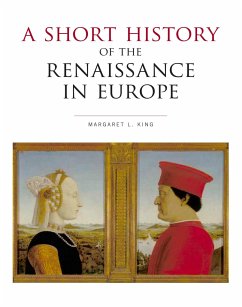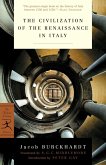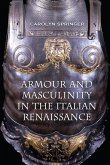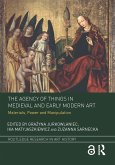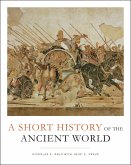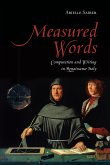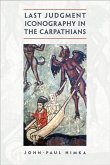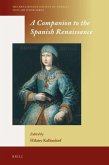Margaret L King
A Short History of the Renaissance in Europe
Margaret L King
A Short History of the Renaissance in Europe
- Broschiertes Buch
- Merkliste
- Auf die Merkliste
- Bewerten Bewerten
- Teilen
- Produkt teilen
- Produkterinnerung
- Produkterinnerung
Margaret L. King's richly illustrated social history of the Renaissance succeeds as a trusted resource, introducing readers to Europe between 1300 -1700, as well as to the problems of cultural renewal.
Andere Kunden interessierten sich auch für
![The Civilization of the Renaissance in Italy The Civilization of the Renaissance in Italy]() Jacob BurckhardtThe Civilization of the Renaissance in Italy15,99 €
Jacob BurckhardtThe Civilization of the Renaissance in Italy15,99 €![Armour and Masculinity in the Italian Renaissance Armour and Masculinity in the Italian Renaissance]() Carolyn SpringerArmour and Masculinity in the Italian Renaissance47,99 €
Carolyn SpringerArmour and Masculinity in the Italian Renaissance47,99 €![The Agency of Things in Medieval and Early Modern Art The Agency of Things in Medieval and Early Modern Art]() The Agency of Things in Medieval and Early Modern Art60,99 €
The Agency of Things in Medieval and Early Modern Art60,99 €![A Short History of the Ancient World A Short History of the Ancient World]() Nicholas K RauhA Short History of the Ancient World98,99 €
Nicholas K RauhA Short History of the Ancient World98,99 €![Measured Words Measured Words]() Arielle SaiberMeasured Words43,99 €
Arielle SaiberMeasured Words43,99 €![Last Judgment Iconography in the Carpathians Last Judgment Iconography in the Carpathians]() John-Paul HimkaLast Judgment Iconography in the Carpathians55,99 €
John-Paul HimkaLast Judgment Iconography in the Carpathians55,99 €![A Companion to the Spanish Renaissance A Companion to the Spanish Renaissance]() A Companion to the Spanish Renaissance93,99 €
A Companion to the Spanish Renaissance93,99 €-
-
-
Margaret L. King's richly illustrated social history of the Renaissance succeeds as a trusted resource, introducing readers to Europe between 1300 -1700, as well as to the problems of cultural renewal.
Hinweis: Dieser Artikel kann nur an eine deutsche Lieferadresse ausgeliefert werden.
Hinweis: Dieser Artikel kann nur an eine deutsche Lieferadresse ausgeliefert werden.
Produktdetails
- Produktdetails
- Verlag: University of Toronto Press
- Seitenzahl: 480
- Erscheinungstermin: 22. September 2016
- Englisch
- Abmessung: 251mm x 203mm x 25mm
- Gewicht: 1021g
- ISBN-13: 9781487593087
- ISBN-10: 1487593082
- Artikelnr.: 46297806
- Herstellerkennzeichnung
- Libri GmbH
- Europaallee 1
- 36244 Bad Hersfeld
- gpsr@libri.de
- Verlag: University of Toronto Press
- Seitenzahl: 480
- Erscheinungstermin: 22. September 2016
- Englisch
- Abmessung: 251mm x 203mm x 25mm
- Gewicht: 1021g
- ISBN-13: 9781487593087
- ISBN-10: 1487593082
- Artikelnr.: 46297806
- Herstellerkennzeichnung
- Libri GmbH
- Europaallee 1
- 36244 Bad Hersfeld
- gpsr@libri.de
Margaret L. King is Professor Emerita of History, Brooklyn College, City University of New York, and has published widely on Venice, women, and humanism in the Renaissance. She is currently Editor in Chief of Oxford Bibliographies Renaissance and Reformation and co-editor of the series The Other Voice in Early Modern Europe.
List of Maps
List of Illustrations
List of Figures, Graphs, and Tables
Acknowledgments
Introduction: The Idea of the Renaissance
Chapter One: Italy and Rome: From Roman Republic to Secondo Popolo (c. 500
BCE-1300 CE)
The Romanization of Italy
Invasion and Destruction
Early Migrations
Focus: Monte Cassino
Germanic Incursions
Cathedral and Monastery
The Authority of the Bishops
The Origins of Monastic Life
Emperor and Pope
The Development of the Holy Roman Empire
Gregory VII and the Drive for Papal Supremacy
Commerce and Reurbanization
Decline of the Roman Economy
Voices: How to Succeed in Business
The Flourishing of Maritime Trade
The Expansion of Trading Networks
The Communal Revolution
Alliance of the Magnates
Triumph of the Lombard League
The Coming of the Popolo
Merchant Guilds
Focus: The Battle of Legnano, 1176
Conflict between Pope and Emperor
The Rebellion of the Popolo
Conclusion
Suggested Readings
Chapter Two: An Age of Republics (c. 1250-c. 1350)
Florence: Banking and Wool
Banking
Focus: Florence
Wool and the Wool Guilds
The Guilds and Civic Life
Revolt of the Ciompi
Focus: Venice
Venice: Shipbuilding and Trade
The Growth of Venice
Shipbuilding and the State
The Venetian Nobility
Urban Renewal: Walls, Buildings, and Spaces
Walls
Buildings
Vita Civile: Urban Culture in a Republican Age
The Jurists
The Secretaries
Voices: Yearning to Be Free
Dante and Giotto: Innovators before the Dawn of the Renaissance
Dante Alighieri
Giotto di Bondone
Voices: Petrarch’s Letter "To Posterity"
Boccaccio and Petrarch: Inaugurators of Renaissance Thought
Boccaccio
Petrarch
Republics and Principalities
The Black Death
Conclusion
Suggested Readings
Chapter Three: Human Dignity and Humanist Studies: The Career of Humanism
(c. 1350-c. 1530)
The Recovery of Classical Antiquity
Focus: Personal Space
Roman Works
Greek Works
The "Studies of Humanity"
The Idea of Humanist Education
Humanist Educational Treatises
The Dignity of Man
Giannozzo Manetti
Pico della Mirandola
Civic Humanism
Voices: Barbaro and Pico
Proposing New Values: Poggio and Valla
Praising the City: Bruni
Voices: Valla’s Logic
Women and Humanism
Early Female Humanists
Later Female Humanists: Nogarola, Cereta, Fedele
Voices: Women and Humanism in Renaissance Italy
Humanism, Philosophy, and Scholarship
Philosophy: Aristotle and Plato
Other Schools
Printing
Textual Scholarship
The Sociology of Humanism
Focus: Aldine Editions
Conclusion
Suggested Readings
Chapter Four: New Visions (c. 1350-c. 1530)
Breakthroughs in Style
Perspective: The Artful Construction of Reality
Patronage and Patrons
Types of Patronage
Focus: New Visions
Florence and Milan
Ferrara, Mantua, and Urbino
Music
Architecture and Urbanism
The Rediscovery of Classical Architecture
Churches
Secular Buildings
Focus: Brunelleschi’s Dome
Voices: Artists and Patrons in Urbino and Venice
City Planning
Portraits and Personality
Portraits and Self-Portraits
Voices: Isabella d’Este
Equestrian Portraits and Tombs
Art and the Everyday
City and Country Settings
Interiors
From Artisan to Genius: The Evolution of the Artist
Vasari
Alberti
Leonardo
Women Artists
The High Renaissance (c. 1500-1530)
Rome
Venice
Conclusion
Suggested Readings
Chapter Five: At Home and in the Piazza (c. 1350-c. 1530)
Public Life
Social Structure
Focus: Prostitutes and Courtesans
Associations
Social Control
Voices: Riot, Plague, and Punishment
Focus: The Jewish Community in the Italian Renaissance
Private Life
The Household
Voices: Death and Consolation
Patriarchy, Property, and Marriage
Voices: The Duties of a Wife
Women and Children
Focus: Childbirth and Childrearing in Renaissance Italy
Conclusion
Suggested Readings
Chapter Six: The Church and the People (c. 1350-c. 1530)
Papacy and the Papal State
The Rise of the Papacy
Focus: Popes and Cardinals
Challenges to the Papacy
Popular Religion
Paganism and Heresy
The Mendicant Movements
Confraternities
Voices: Brothers (Sisters) in Christ
Holy Women
Saints and Martyrs
Focus: Holy Women and Unwilling Nuns
Catherine of Siena
Francesca of Rome
Catherine of Bologna
Catherine of Genoa
Angela Merici
Pastors of the Flock
Archbishops and Bishops
Preachers and Visionaries
Bernardino of Siena
Girolamo Savonarola
Conclusion
Suggested Readings
Chapter Seven: Statecraft and Warcraft (c. 1350-c. 1530)
The Tide of Despotism
The Organization of Violence
Focus: Warriors for Hire
Padua and Verona
The Visconti in Milan
Ferrara, Mantua, and Urbino
The Papal States and the Two Sicilies
Voices: A Despot’s Advice and a Republican’s Lament
Freedom versus Tyranny
Balance of Power
Councils and Commissions
Focus: The Machinery of Government in Venice
The Trend toward Oligarchy
Administering Justice
Raising Revenues
Focus: The Medici
Diplomacy
Venice and Florence Expand
Military Organization
War and Peace
Invasion and Conquest
The French Invasion to the Battle of Fornovo
The Great Captain and the Conquest of Naples
Julius II and the Battle of Agnadello
The Holy League and the Battle of Marignano
Habsburg versus Valois to the Battle of Pavia ¿ 247
The Sack of Rome
The Return of the Medici
Voices: The Republican Spirit in Florence
Conclusion
Suggested Readings
Chapter Eight: The Crisis and Beyond (c. 1500-c. 1650)
The Machiavellian Moment
Machiavelli’s Career
Machiavelli’s Thought
Machiavelli’s Political Vision
Courts and Princes: Castiglione’s The Courtier
Book One
Book Two
Book Three
Book Four
Influence
The States of Italy after c. 1530
Ideas and the Arts in Late Renaissance Italy
The Visual Arts
Focus: Womanly Perspective
The Performing Arts
Literature and Literary Trends
Focus: The Origins of Opera
Voices: Pietro Aretino, "Scourge of Princes"
Science, Medicine, and Philosophy
Voices: Women and Love
Conclusion
Suggested Readings
Chapter Nine: The Renaissance and the Two Reformations (c. 1500-c. 1650)
Visitors and Emissaries
Printing, Humanism, and Reform
The Manuscript Book
The Printed Book: Early Years
The Printed Book: Later Developments
Focus: The English Century
Erasmus, More, and Vives
Erasmus
Focus: The Enchantments of Nowhere
More and Utopia
Vives and the Erasmian Mission
The Reformations and the Humanist Tradition
Protestants
Voices: Luther and Calvin on Liberty and Free Will
The Catholic Response
Voices: The Catholic Response: The Council of Trent, Ignatius of Loyola,
and Teresa of Ávila
Intersections
Conclusion
Suggested Readings
Chapter Ten: The Renaissance beyond the Alps: Cities, Courts, and Kings (c.
1500-c. 1700)
Contexts: Kingdoms, Courts, and Cities
Kingdoms
Courts
Cities
Focus: Early Modern Cities
Centers of the Renaissance beyond the Alps
Spain and Portugal
Voices: Spanish Sketches
The Low Countries
Focus: The Low Countries: Interiors and Exteriors
France
The British Isles
Voices: In Search of Authenticity
The German Lands
Northern and Eastern Europe
Conclusion
Suggested Readings
Chapter Eleven: The Renaissance and New Worlds (c. 1500-c. 1700)
The New World in the Ocean Sea
The Mediterranean
Focus: The Renaissance and Globalization
Portuguese Ventures
Spanish Exploration and Conquest
Indigenous Peoples, Africans, and the Slave Trade
North America and the Triangle Trade
The Impact on European Consciousness
New Heavens, New Earth
Cosmographical Revisions
Voices: Scientific Observers
Other Scientific Advances
Voices: Discerning Truth
New Ways to Reason
Focus: Educating the Few-and the Many
Toward Enlightenment
Readers and Learners
Women and the World of Learning
Focus: The Worth of Women
Conclusion
Suggested Readings
Glossary
Credits
Index
List of Illustrations
List of Figures, Graphs, and Tables
Acknowledgments
Introduction: The Idea of the Renaissance
Chapter One: Italy and Rome: From Roman Republic to Secondo Popolo (c. 500
BCE-1300 CE)
The Romanization of Italy
Invasion and Destruction
Early Migrations
Focus: Monte Cassino
Germanic Incursions
Cathedral and Monastery
The Authority of the Bishops
The Origins of Monastic Life
Emperor and Pope
The Development of the Holy Roman Empire
Gregory VII and the Drive for Papal Supremacy
Commerce and Reurbanization
Decline of the Roman Economy
Voices: How to Succeed in Business
The Flourishing of Maritime Trade
The Expansion of Trading Networks
The Communal Revolution
Alliance of the Magnates
Triumph of the Lombard League
The Coming of the Popolo
Merchant Guilds
Focus: The Battle of Legnano, 1176
Conflict between Pope and Emperor
The Rebellion of the Popolo
Conclusion
Suggested Readings
Chapter Two: An Age of Republics (c. 1250-c. 1350)
Florence: Banking and Wool
Banking
Focus: Florence
Wool and the Wool Guilds
The Guilds and Civic Life
Revolt of the Ciompi
Focus: Venice
Venice: Shipbuilding and Trade
The Growth of Venice
Shipbuilding and the State
The Venetian Nobility
Urban Renewal: Walls, Buildings, and Spaces
Walls
Buildings
Vita Civile: Urban Culture in a Republican Age
The Jurists
The Secretaries
Voices: Yearning to Be Free
Dante and Giotto: Innovators before the Dawn of the Renaissance
Dante Alighieri
Giotto di Bondone
Voices: Petrarch’s Letter "To Posterity"
Boccaccio and Petrarch: Inaugurators of Renaissance Thought
Boccaccio
Petrarch
Republics and Principalities
The Black Death
Conclusion
Suggested Readings
Chapter Three: Human Dignity and Humanist Studies: The Career of Humanism
(c. 1350-c. 1530)
The Recovery of Classical Antiquity
Focus: Personal Space
Roman Works
Greek Works
The "Studies of Humanity"
The Idea of Humanist Education
Humanist Educational Treatises
The Dignity of Man
Giannozzo Manetti
Pico della Mirandola
Civic Humanism
Voices: Barbaro and Pico
Proposing New Values: Poggio and Valla
Praising the City: Bruni
Voices: Valla’s Logic
Women and Humanism
Early Female Humanists
Later Female Humanists: Nogarola, Cereta, Fedele
Voices: Women and Humanism in Renaissance Italy
Humanism, Philosophy, and Scholarship
Philosophy: Aristotle and Plato
Other Schools
Printing
Textual Scholarship
The Sociology of Humanism
Focus: Aldine Editions
Conclusion
Suggested Readings
Chapter Four: New Visions (c. 1350-c. 1530)
Breakthroughs in Style
Perspective: The Artful Construction of Reality
Patronage and Patrons
Types of Patronage
Focus: New Visions
Florence and Milan
Ferrara, Mantua, and Urbino
Music
Architecture and Urbanism
The Rediscovery of Classical Architecture
Churches
Secular Buildings
Focus: Brunelleschi’s Dome
Voices: Artists and Patrons in Urbino and Venice
City Planning
Portraits and Personality
Portraits and Self-Portraits
Voices: Isabella d’Este
Equestrian Portraits and Tombs
Art and the Everyday
City and Country Settings
Interiors
From Artisan to Genius: The Evolution of the Artist
Vasari
Alberti
Leonardo
Women Artists
The High Renaissance (c. 1500-1530)
Rome
Venice
Conclusion
Suggested Readings
Chapter Five: At Home and in the Piazza (c. 1350-c. 1530)
Public Life
Social Structure
Focus: Prostitutes and Courtesans
Associations
Social Control
Voices: Riot, Plague, and Punishment
Focus: The Jewish Community in the Italian Renaissance
Private Life
The Household
Voices: Death and Consolation
Patriarchy, Property, and Marriage
Voices: The Duties of a Wife
Women and Children
Focus: Childbirth and Childrearing in Renaissance Italy
Conclusion
Suggested Readings
Chapter Six: The Church and the People (c. 1350-c. 1530)
Papacy and the Papal State
The Rise of the Papacy
Focus: Popes and Cardinals
Challenges to the Papacy
Popular Religion
Paganism and Heresy
The Mendicant Movements
Confraternities
Voices: Brothers (Sisters) in Christ
Holy Women
Saints and Martyrs
Focus: Holy Women and Unwilling Nuns
Catherine of Siena
Francesca of Rome
Catherine of Bologna
Catherine of Genoa
Angela Merici
Pastors of the Flock
Archbishops and Bishops
Preachers and Visionaries
Bernardino of Siena
Girolamo Savonarola
Conclusion
Suggested Readings
Chapter Seven: Statecraft and Warcraft (c. 1350-c. 1530)
The Tide of Despotism
The Organization of Violence
Focus: Warriors for Hire
Padua and Verona
The Visconti in Milan
Ferrara, Mantua, and Urbino
The Papal States and the Two Sicilies
Voices: A Despot’s Advice and a Republican’s Lament
Freedom versus Tyranny
Balance of Power
Councils and Commissions
Focus: The Machinery of Government in Venice
The Trend toward Oligarchy
Administering Justice
Raising Revenues
Focus: The Medici
Diplomacy
Venice and Florence Expand
Military Organization
War and Peace
Invasion and Conquest
The French Invasion to the Battle of Fornovo
The Great Captain and the Conquest of Naples
Julius II and the Battle of Agnadello
The Holy League and the Battle of Marignano
Habsburg versus Valois to the Battle of Pavia ¿ 247
The Sack of Rome
The Return of the Medici
Voices: The Republican Spirit in Florence
Conclusion
Suggested Readings
Chapter Eight: The Crisis and Beyond (c. 1500-c. 1650)
The Machiavellian Moment
Machiavelli’s Career
Machiavelli’s Thought
Machiavelli’s Political Vision
Courts and Princes: Castiglione’s The Courtier
Book One
Book Two
Book Three
Book Four
Influence
The States of Italy after c. 1530
Ideas and the Arts in Late Renaissance Italy
The Visual Arts
Focus: Womanly Perspective
The Performing Arts
Literature and Literary Trends
Focus: The Origins of Opera
Voices: Pietro Aretino, "Scourge of Princes"
Science, Medicine, and Philosophy
Voices: Women and Love
Conclusion
Suggested Readings
Chapter Nine: The Renaissance and the Two Reformations (c. 1500-c. 1650)
Visitors and Emissaries
Printing, Humanism, and Reform
The Manuscript Book
The Printed Book: Early Years
The Printed Book: Later Developments
Focus: The English Century
Erasmus, More, and Vives
Erasmus
Focus: The Enchantments of Nowhere
More and Utopia
Vives and the Erasmian Mission
The Reformations and the Humanist Tradition
Protestants
Voices: Luther and Calvin on Liberty and Free Will
The Catholic Response
Voices: The Catholic Response: The Council of Trent, Ignatius of Loyola,
and Teresa of Ávila
Intersections
Conclusion
Suggested Readings
Chapter Ten: The Renaissance beyond the Alps: Cities, Courts, and Kings (c.
1500-c. 1700)
Contexts: Kingdoms, Courts, and Cities
Kingdoms
Courts
Cities
Focus: Early Modern Cities
Centers of the Renaissance beyond the Alps
Spain and Portugal
Voices: Spanish Sketches
The Low Countries
Focus: The Low Countries: Interiors and Exteriors
France
The British Isles
Voices: In Search of Authenticity
The German Lands
Northern and Eastern Europe
Conclusion
Suggested Readings
Chapter Eleven: The Renaissance and New Worlds (c. 1500-c. 1700)
The New World in the Ocean Sea
The Mediterranean
Focus: The Renaissance and Globalization
Portuguese Ventures
Spanish Exploration and Conquest
Indigenous Peoples, Africans, and the Slave Trade
North America and the Triangle Trade
The Impact on European Consciousness
New Heavens, New Earth
Cosmographical Revisions
Voices: Scientific Observers
Other Scientific Advances
Voices: Discerning Truth
New Ways to Reason
Focus: Educating the Few-and the Many
Toward Enlightenment
Readers and Learners
Women and the World of Learning
Focus: The Worth of Women
Conclusion
Suggested Readings
Glossary
Credits
Index
List of Maps
List of Illustrations
List of Figures, Graphs, and Tables
Acknowledgments
Introduction: The Idea of the Renaissance
Chapter One: Italy and Rome: From Roman Republic to Secondo Popolo (c. 500
BCE-1300 CE)
The Romanization of Italy
Invasion and Destruction
Early Migrations
Focus: Monte Cassino
Germanic Incursions
Cathedral and Monastery
The Authority of the Bishops
The Origins of Monastic Life
Emperor and Pope
The Development of the Holy Roman Empire
Gregory VII and the Drive for Papal Supremacy
Commerce and Reurbanization
Decline of the Roman Economy
Voices: How to Succeed in Business
The Flourishing of Maritime Trade
The Expansion of Trading Networks
The Communal Revolution
Alliance of the Magnates
Triumph of the Lombard League
The Coming of the Popolo
Merchant Guilds
Focus: The Battle of Legnano, 1176
Conflict between Pope and Emperor
The Rebellion of the Popolo
Conclusion
Suggested Readings
Chapter Two: An Age of Republics (c. 1250-c. 1350)
Florence: Banking and Wool
Banking
Focus: Florence
Wool and the Wool Guilds
The Guilds and Civic Life
Revolt of the Ciompi
Focus: Venice
Venice: Shipbuilding and Trade
The Growth of Venice
Shipbuilding and the State
The Venetian Nobility
Urban Renewal: Walls, Buildings, and Spaces
Walls
Buildings
Vita Civile: Urban Culture in a Republican Age
The Jurists
The Secretaries
Voices: Yearning to Be Free
Dante and Giotto: Innovators before the Dawn of the Renaissance
Dante Alighieri
Giotto di Bondone
Voices: Petrarch’s Letter "To Posterity"
Boccaccio and Petrarch: Inaugurators of Renaissance Thought
Boccaccio
Petrarch
Republics and Principalities
The Black Death
Conclusion
Suggested Readings
Chapter Three: Human Dignity and Humanist Studies: The Career of Humanism
(c. 1350-c. 1530)
The Recovery of Classical Antiquity
Focus: Personal Space
Roman Works
Greek Works
The "Studies of Humanity"
The Idea of Humanist Education
Humanist Educational Treatises
The Dignity of Man
Giannozzo Manetti
Pico della Mirandola
Civic Humanism
Voices: Barbaro and Pico
Proposing New Values: Poggio and Valla
Praising the City: Bruni
Voices: Valla’s Logic
Women and Humanism
Early Female Humanists
Later Female Humanists: Nogarola, Cereta, Fedele
Voices: Women and Humanism in Renaissance Italy
Humanism, Philosophy, and Scholarship
Philosophy: Aristotle and Plato
Other Schools
Printing
Textual Scholarship
The Sociology of Humanism
Focus: Aldine Editions
Conclusion
Suggested Readings
Chapter Four: New Visions (c. 1350-c. 1530)
Breakthroughs in Style
Perspective: The Artful Construction of Reality
Patronage and Patrons
Types of Patronage
Focus: New Visions
Florence and Milan
Ferrara, Mantua, and Urbino
Music
Architecture and Urbanism
The Rediscovery of Classical Architecture
Churches
Secular Buildings
Focus: Brunelleschi’s Dome
Voices: Artists and Patrons in Urbino and Venice
City Planning
Portraits and Personality
Portraits and Self-Portraits
Voices: Isabella d’Este
Equestrian Portraits and Tombs
Art and the Everyday
City and Country Settings
Interiors
From Artisan to Genius: The Evolution of the Artist
Vasari
Alberti
Leonardo
Women Artists
The High Renaissance (c. 1500-1530)
Rome
Venice
Conclusion
Suggested Readings
Chapter Five: At Home and in the Piazza (c. 1350-c. 1530)
Public Life
Social Structure
Focus: Prostitutes and Courtesans
Associations
Social Control
Voices: Riot, Plague, and Punishment
Focus: The Jewish Community in the Italian Renaissance
Private Life
The Household
Voices: Death and Consolation
Patriarchy, Property, and Marriage
Voices: The Duties of a Wife
Women and Children
Focus: Childbirth and Childrearing in Renaissance Italy
Conclusion
Suggested Readings
Chapter Six: The Church and the People (c. 1350-c. 1530)
Papacy and the Papal State
The Rise of the Papacy
Focus: Popes and Cardinals
Challenges to the Papacy
Popular Religion
Paganism and Heresy
The Mendicant Movements
Confraternities
Voices: Brothers (Sisters) in Christ
Holy Women
Saints and Martyrs
Focus: Holy Women and Unwilling Nuns
Catherine of Siena
Francesca of Rome
Catherine of Bologna
Catherine of Genoa
Angela Merici
Pastors of the Flock
Archbishops and Bishops
Preachers and Visionaries
Bernardino of Siena
Girolamo Savonarola
Conclusion
Suggested Readings
Chapter Seven: Statecraft and Warcraft (c. 1350-c. 1530)
The Tide of Despotism
The Organization of Violence
Focus: Warriors for Hire
Padua and Verona
The Visconti in Milan
Ferrara, Mantua, and Urbino
The Papal States and the Two Sicilies
Voices: A Despot’s Advice and a Republican’s Lament
Freedom versus Tyranny
Balance of Power
Councils and Commissions
Focus: The Machinery of Government in Venice
The Trend toward Oligarchy
Administering Justice
Raising Revenues
Focus: The Medici
Diplomacy
Venice and Florence Expand
Military Organization
War and Peace
Invasion and Conquest
The French Invasion to the Battle of Fornovo
The Great Captain and the Conquest of Naples
Julius II and the Battle of Agnadello
The Holy League and the Battle of Marignano
Habsburg versus Valois to the Battle of Pavia ¿ 247
The Sack of Rome
The Return of the Medici
Voices: The Republican Spirit in Florence
Conclusion
Suggested Readings
Chapter Eight: The Crisis and Beyond (c. 1500-c. 1650)
The Machiavellian Moment
Machiavelli’s Career
Machiavelli’s Thought
Machiavelli’s Political Vision
Courts and Princes: Castiglione’s The Courtier
Book One
Book Two
Book Three
Book Four
Influence
The States of Italy after c. 1530
Ideas and the Arts in Late Renaissance Italy
The Visual Arts
Focus: Womanly Perspective
The Performing Arts
Literature and Literary Trends
Focus: The Origins of Opera
Voices: Pietro Aretino, "Scourge of Princes"
Science, Medicine, and Philosophy
Voices: Women and Love
Conclusion
Suggested Readings
Chapter Nine: The Renaissance and the Two Reformations (c. 1500-c. 1650)
Visitors and Emissaries
Printing, Humanism, and Reform
The Manuscript Book
The Printed Book: Early Years
The Printed Book: Later Developments
Focus: The English Century
Erasmus, More, and Vives
Erasmus
Focus: The Enchantments of Nowhere
More and Utopia
Vives and the Erasmian Mission
The Reformations and the Humanist Tradition
Protestants
Voices: Luther and Calvin on Liberty and Free Will
The Catholic Response
Voices: The Catholic Response: The Council of Trent, Ignatius of Loyola,
and Teresa of Ávila
Intersections
Conclusion
Suggested Readings
Chapter Ten: The Renaissance beyond the Alps: Cities, Courts, and Kings (c.
1500-c. 1700)
Contexts: Kingdoms, Courts, and Cities
Kingdoms
Courts
Cities
Focus: Early Modern Cities
Centers of the Renaissance beyond the Alps
Spain and Portugal
Voices: Spanish Sketches
The Low Countries
Focus: The Low Countries: Interiors and Exteriors
France
The British Isles
Voices: In Search of Authenticity
The German Lands
Northern and Eastern Europe
Conclusion
Suggested Readings
Chapter Eleven: The Renaissance and New Worlds (c. 1500-c. 1700)
The New World in the Ocean Sea
The Mediterranean
Focus: The Renaissance and Globalization
Portuguese Ventures
Spanish Exploration and Conquest
Indigenous Peoples, Africans, and the Slave Trade
North America and the Triangle Trade
The Impact on European Consciousness
New Heavens, New Earth
Cosmographical Revisions
Voices: Scientific Observers
Other Scientific Advances
Voices: Discerning Truth
New Ways to Reason
Focus: Educating the Few-and the Many
Toward Enlightenment
Readers and Learners
Women and the World of Learning
Focus: The Worth of Women
Conclusion
Suggested Readings
Glossary
Credits
Index
List of Illustrations
List of Figures, Graphs, and Tables
Acknowledgments
Introduction: The Idea of the Renaissance
Chapter One: Italy and Rome: From Roman Republic to Secondo Popolo (c. 500
BCE-1300 CE)
The Romanization of Italy
Invasion and Destruction
Early Migrations
Focus: Monte Cassino
Germanic Incursions
Cathedral and Monastery
The Authority of the Bishops
The Origins of Monastic Life
Emperor and Pope
The Development of the Holy Roman Empire
Gregory VII and the Drive for Papal Supremacy
Commerce and Reurbanization
Decline of the Roman Economy
Voices: How to Succeed in Business
The Flourishing of Maritime Trade
The Expansion of Trading Networks
The Communal Revolution
Alliance of the Magnates
Triumph of the Lombard League
The Coming of the Popolo
Merchant Guilds
Focus: The Battle of Legnano, 1176
Conflict between Pope and Emperor
The Rebellion of the Popolo
Conclusion
Suggested Readings
Chapter Two: An Age of Republics (c. 1250-c. 1350)
Florence: Banking and Wool
Banking
Focus: Florence
Wool and the Wool Guilds
The Guilds and Civic Life
Revolt of the Ciompi
Focus: Venice
Venice: Shipbuilding and Trade
The Growth of Venice
Shipbuilding and the State
The Venetian Nobility
Urban Renewal: Walls, Buildings, and Spaces
Walls
Buildings
Vita Civile: Urban Culture in a Republican Age
The Jurists
The Secretaries
Voices: Yearning to Be Free
Dante and Giotto: Innovators before the Dawn of the Renaissance
Dante Alighieri
Giotto di Bondone
Voices: Petrarch’s Letter "To Posterity"
Boccaccio and Petrarch: Inaugurators of Renaissance Thought
Boccaccio
Petrarch
Republics and Principalities
The Black Death
Conclusion
Suggested Readings
Chapter Three: Human Dignity and Humanist Studies: The Career of Humanism
(c. 1350-c. 1530)
The Recovery of Classical Antiquity
Focus: Personal Space
Roman Works
Greek Works
The "Studies of Humanity"
The Idea of Humanist Education
Humanist Educational Treatises
The Dignity of Man
Giannozzo Manetti
Pico della Mirandola
Civic Humanism
Voices: Barbaro and Pico
Proposing New Values: Poggio and Valla
Praising the City: Bruni
Voices: Valla’s Logic
Women and Humanism
Early Female Humanists
Later Female Humanists: Nogarola, Cereta, Fedele
Voices: Women and Humanism in Renaissance Italy
Humanism, Philosophy, and Scholarship
Philosophy: Aristotle and Plato
Other Schools
Printing
Textual Scholarship
The Sociology of Humanism
Focus: Aldine Editions
Conclusion
Suggested Readings
Chapter Four: New Visions (c. 1350-c. 1530)
Breakthroughs in Style
Perspective: The Artful Construction of Reality
Patronage and Patrons
Types of Patronage
Focus: New Visions
Florence and Milan
Ferrara, Mantua, and Urbino
Music
Architecture and Urbanism
The Rediscovery of Classical Architecture
Churches
Secular Buildings
Focus: Brunelleschi’s Dome
Voices: Artists and Patrons in Urbino and Venice
City Planning
Portraits and Personality
Portraits and Self-Portraits
Voices: Isabella d’Este
Equestrian Portraits and Tombs
Art and the Everyday
City and Country Settings
Interiors
From Artisan to Genius: The Evolution of the Artist
Vasari
Alberti
Leonardo
Women Artists
The High Renaissance (c. 1500-1530)
Rome
Venice
Conclusion
Suggested Readings
Chapter Five: At Home and in the Piazza (c. 1350-c. 1530)
Public Life
Social Structure
Focus: Prostitutes and Courtesans
Associations
Social Control
Voices: Riot, Plague, and Punishment
Focus: The Jewish Community in the Italian Renaissance
Private Life
The Household
Voices: Death and Consolation
Patriarchy, Property, and Marriage
Voices: The Duties of a Wife
Women and Children
Focus: Childbirth and Childrearing in Renaissance Italy
Conclusion
Suggested Readings
Chapter Six: The Church and the People (c. 1350-c. 1530)
Papacy and the Papal State
The Rise of the Papacy
Focus: Popes and Cardinals
Challenges to the Papacy
Popular Religion
Paganism and Heresy
The Mendicant Movements
Confraternities
Voices: Brothers (Sisters) in Christ
Holy Women
Saints and Martyrs
Focus: Holy Women and Unwilling Nuns
Catherine of Siena
Francesca of Rome
Catherine of Bologna
Catherine of Genoa
Angela Merici
Pastors of the Flock
Archbishops and Bishops
Preachers and Visionaries
Bernardino of Siena
Girolamo Savonarola
Conclusion
Suggested Readings
Chapter Seven: Statecraft and Warcraft (c. 1350-c. 1530)
The Tide of Despotism
The Organization of Violence
Focus: Warriors for Hire
Padua and Verona
The Visconti in Milan
Ferrara, Mantua, and Urbino
The Papal States and the Two Sicilies
Voices: A Despot’s Advice and a Republican’s Lament
Freedom versus Tyranny
Balance of Power
Councils and Commissions
Focus: The Machinery of Government in Venice
The Trend toward Oligarchy
Administering Justice
Raising Revenues
Focus: The Medici
Diplomacy
Venice and Florence Expand
Military Organization
War and Peace
Invasion and Conquest
The French Invasion to the Battle of Fornovo
The Great Captain and the Conquest of Naples
Julius II and the Battle of Agnadello
The Holy League and the Battle of Marignano
Habsburg versus Valois to the Battle of Pavia ¿ 247
The Sack of Rome
The Return of the Medici
Voices: The Republican Spirit in Florence
Conclusion
Suggested Readings
Chapter Eight: The Crisis and Beyond (c. 1500-c. 1650)
The Machiavellian Moment
Machiavelli’s Career
Machiavelli’s Thought
Machiavelli’s Political Vision
Courts and Princes: Castiglione’s The Courtier
Book One
Book Two
Book Three
Book Four
Influence
The States of Italy after c. 1530
Ideas and the Arts in Late Renaissance Italy
The Visual Arts
Focus: Womanly Perspective
The Performing Arts
Literature and Literary Trends
Focus: The Origins of Opera
Voices: Pietro Aretino, "Scourge of Princes"
Science, Medicine, and Philosophy
Voices: Women and Love
Conclusion
Suggested Readings
Chapter Nine: The Renaissance and the Two Reformations (c. 1500-c. 1650)
Visitors and Emissaries
Printing, Humanism, and Reform
The Manuscript Book
The Printed Book: Early Years
The Printed Book: Later Developments
Focus: The English Century
Erasmus, More, and Vives
Erasmus
Focus: The Enchantments of Nowhere
More and Utopia
Vives and the Erasmian Mission
The Reformations and the Humanist Tradition
Protestants
Voices: Luther and Calvin on Liberty and Free Will
The Catholic Response
Voices: The Catholic Response: The Council of Trent, Ignatius of Loyola,
and Teresa of Ávila
Intersections
Conclusion
Suggested Readings
Chapter Ten: The Renaissance beyond the Alps: Cities, Courts, and Kings (c.
1500-c. 1700)
Contexts: Kingdoms, Courts, and Cities
Kingdoms
Courts
Cities
Focus: Early Modern Cities
Centers of the Renaissance beyond the Alps
Spain and Portugal
Voices: Spanish Sketches
The Low Countries
Focus: The Low Countries: Interiors and Exteriors
France
The British Isles
Voices: In Search of Authenticity
The German Lands
Northern and Eastern Europe
Conclusion
Suggested Readings
Chapter Eleven: The Renaissance and New Worlds (c. 1500-c. 1700)
The New World in the Ocean Sea
The Mediterranean
Focus: The Renaissance and Globalization
Portuguese Ventures
Spanish Exploration and Conquest
Indigenous Peoples, Africans, and the Slave Trade
North America and the Triangle Trade
The Impact on European Consciousness
New Heavens, New Earth
Cosmographical Revisions
Voices: Scientific Observers
Other Scientific Advances
Voices: Discerning Truth
New Ways to Reason
Focus: Educating the Few-and the Many
Toward Enlightenment
Readers and Learners
Women and the World of Learning
Focus: The Worth of Women
Conclusion
Suggested Readings
Glossary
Credits
Index

